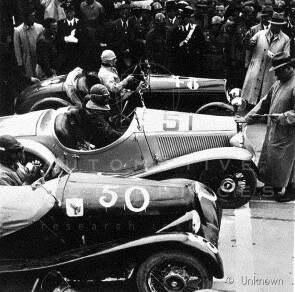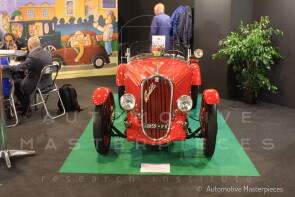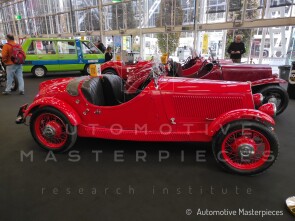
1935 Fiat 508 S Balilla Sport
ON/OFF
Why am I an Automotive Masterpiece?
L. Limited edition cars
no. 250 manufactured. Approximate number.
Launched in 1932, the Fiat 508 Balilla quickly established itself as the car that put Italy on wheels. Developed under the technical direction of Tranquillo Zerbi, with contributions from Antonio Fessia and Dante Giacosa, the Balilla was designed to embody the regime’s ambition of creating an affordable national car. Its release aligned with the Fascist government’s push for modernization and industrial self-sufficiency, aiming to broaden access to mobility and reinforce national pride through Italian engineering. The car’s success stemmed from its low purchase price, modest operating costs, and ease of maintenance—key factors in a country still emerging from postwar economic hardship. Powered by a 995-cc inline four-cylinder side-valve engine producing around 20 hp, the Balilla offered adequate performance for its class. It featured a three-speed gearbox, rear-wheel drive, and a simple yet robust ladder-frame chassis with solid axles and leaf springs, prioritizing reliability and ease of repair. Compact, mechanically straightforward, and affordable, the Balilla became a cornerstone of Italian mass motorization. It was not only popular among private buyers, but also widely used in commercial and institutional roles—becoming a true icon of Fiat’s pre-war production and Italy’s automotive awakening.
The 508 S Balilla Sport, a competition version, was inspired by an original design by Carrozzeria Ghia. The first examples were built on the Fiat 508 Spyder chassis, suitably modified as “tipo corsa” (i.e. racing type), and still bore chassis numbers without the letter "S". In 1933, Fiat officially introduced the sporting version 508 S Balilla Sport, characterized by a lighter, elegant, and attractive body, which soon became a dream car for the younger generation. Fiat acquired the design rights from Ghia and produced two versions: the standard version, known as “Coppa d’Oro”, featured fully enclosed fenders, while the “Mille Miglia” version used lighter cycle fenders and a more lightweight chassis. The engine was also uprated from the standard 36 hp to 43 hp. The Coppa d’Oro version won the Coppa d’Oro del Littorio, from which it took its nickname, while the Mille Miglia version won the 1933 Mille Miglia in the up to 1100 cc Utility Class. Clothed in stylish open two-seater bodywork with a distinctive finned tail, the early "Spider Sport" models retained the crash gearbox of the standard cars but featured a special carburetor. Combined with a raised compression ratio of 7:1, this allowed for a maximum output of 30 hp at 4,000 rpm. In 1934, the second series 508 CS was introduced, improving on this successful formula. It adopted a four-speed synchromesh gearbox and an overhead-valve engine producing 46 hp. The final drive ratio was also modified, allowing for a top speed of 110 km/h. At the time, Siata was already producing accessories and performance parts for the Balilla, making it arguably one of the earliest car tuning companies in automotive history.
The Balilla Sport with chassis no. 508S* 071685* is an example of the so-called second series, equipped with the 108 CS overhead-valve engine and a 4-speed gearbox. The car was completed in May 1935 and registered to Ovidio Capelli, later a leading Fiat dealer and accomplished racing driver, known for his involvement with Scuderia Ambrosiana and for commissioning the first Fiat 8V Zagato, helping launch the iconic collaboration. With Capelli the car took part, that same August, in the international “Grossglockner-Rennen” hillclimb, racing under number 56. In April 1936, again with Capelli, the car entered the Coppa della Mille Miglia. Period documents record a curious detail: in keeping with the Fascist regime’s autarkic policies and propaganda, Capelli registered the car in the category for “non-supercharged cars using substitute liquid fuel.” However, only ten days later, Capelli sent a communication to the CSAI (Italian Motorsport Commission) correcting this, stating that the car would in fact compete using standard fuel. The reasons for this change remain unknown—it may have been due to supply issues, cost, tactical decisions, or performance considerations. The Mille Miglia entry ended shortly after Siena, due to an accident in which Capelli emerged unscathed, while his co-driver, Nagas, sustained minor injuries. The car changed hands several times thereafter, but took part in at least one more prewar competition: the Circuito Automobilistico dell’Agro Pontino, in May 1937. Among its later owners were, notably, the Ente Teatrale Italiano in Rome, which acquired the car in November 1947—a public institution created to promote and support theatrical activity across Italy—and Dr. Giacomo Baruzzi of Massa Fiscaglia (Ferrara), a physician and philanthropist active in the second half of the 20th century. All owners and license plates are traceable. The car has been fully restored and has received a FIVA passport. It took part to a Mille Miglia Renactment in 1989 and was shown at Auto e Moto d’Epoca in 2021 and 2023. It was sold by the Ruote da Sogno dealership to a private collection.




